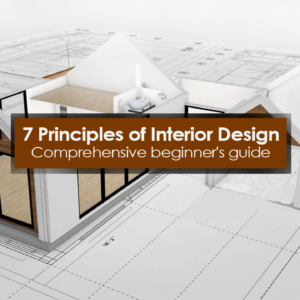
Login
X
- Home
- About Us
- Courses
- Graduation
- Diploma Certificate
- Professional Diploma
- Special sessions / Aptitude boost up
- News & Events
- Student zone
- Placement
- Gallery
- FAQ
- Contact Us

7 principles of interior design are widely accepted by everyone in the industry. It is tried and true recipe to create interior spaces that are functional and aesthetically pleasing at the same time. Like the golden ratio in architecture the 7 principles also enhance and elevate the interior design.
Let’s dive deeper and get to know all seven principles of interior design.
The first thing to keep in mind is balance. What is balance in terms of interior designing? It is referred to as “visual weight” distribution. “Visual weight” refers to how heavy or how light an object appears to the human eye. Large, solid, dark, or colorful seems heavier to the eye than small, thin, open, or light objects seem lighter to the eye.
A good way to ensure that the visual weight distribution is good is by dividing the space into 4 quadrants and each quadrant should contain roughly the same amount of furnishing.
Like the music, repetition helps in visual appeal too. Just as creating musical patterns creating a visual pattern is necessary for interior designing. It creates a space that is cohesive and gives a seamless moment to the eye to flow around the room. The element for repetition can be anything from texture, shape, pattern to finished materials.
Try to create a focal point. It can be something inbuilt like a fireplace or something that is deliberately placed in a way like a piece of art or furniture. Lay the design around the focal point such that it is the first thing someone will notice when entering the room.
To make sure the interior is not boring contrast and variety, to say the least, is a must. Additionally, contrast gives the space drama and variety adds diversity and personality. You can achieve it by pairing contrasting colors, shapes, and textures
Scale and proportion will ensure that objects in the room belong and relate to each other. Proportion refers to the size of one object concerning another while Scale refers to the size of objects within a space.
Unity and harmony ensure that everything goes with everything else in the room. It is achieved when the design and furniture follow the theme. Decorating accordingly with items that have common colors, patterns, shape, or style will help to achieve unity and harmony

Interior design course details on frequently asked questions are given below. Please refer to the below questions. for more details contact us at 0495 2722242
BSc interior designing is a three-year course that equips aspiring interior designers with the necessary skills needed for it. In the three years of the course, several core topics about Interior designing are addressed, practical’s an internship. Interior designing is not just artistic talent, the process of interior designing involves scientific, logical, and creative thinking.
Communication Skills
Basics of Interior Design
Environmental Studies
Cost Estimation
Construction Technology
Materials and Finishes
Colour Theory and Techniques
Design Theory
Materials and Finishes
Colour Theory and Techniques
Design Theory
Material Purchase
Furniture Design
Model Making
Design Technology
Drawing (Technical)
Design Practice
There are a variety of different job opportunities here is a list of few
Product Designer
Furniture Designer
User Experience Designer
Interior Designer
Set Designer
Interior Elements Advisor
Interior Space Consultant
Model Maker
Portfolio Designer
Blogger
Interior Decorators
Bathroom Designers
Universal Designers
Sustainable Designers
Industrial Designers
Professor of Interior Design
Exhibition Designer
Kitchen Designer
Healthcare Designer
Corporate Designer
Lighting Designer
Architectural Technologist
Production Designer.
BSc Interior design (by Barathiyar University)
Interior designing is a multi-faceted profession which includes numerous element that needs to work together.
First and foremost is research and analysis of the client’s goals. Sit with the client to understand their wants and needs also their likes and dislikes. Form schemas and plans with the help of two and three-dimensional design concepts that integrate knowledge, creativity, principles of interior design, and client needs. Then comes the selection process which includes finding furniture, fixtures, and equipment. Creating layout drawing, detailed product description, provision of contract documentation to facilitate pricing, procurement, and installation of furniture. Preparation of construction documents, consisting of plans, elevations, materials and finishes details and specifications, power and communications locations; reflected ceiling plans and lighting designs; and furniture layout. Collaborating and coordinating with various allied professions for plumping, electrical wiring, etc. Observing and reporting while the project is in progress till completion.

Multimedia and its applications are vast and varying . There are a plethora of definitions of the word multimedia. It is roughly defined as a computer-controlled integration of text, audio, video, animation, and any other media that is stored digitally, signified, and transmitted. Multimedia and its application are an integral part of day-to-day modern life.
Multimedia can be both linear and nonlinear. The direct active context that requires no navigation or interaction control is linear multimedia. Movies are a good example of linear multimedia. Non-linear content is also known as hypermedia content uses interactive navigation control. Games use non-linear content to provide user interface and navigation.
for multimedia and its applications different elements play a vital role.
The most basic and well-known form of multimedia is text. It is the foundation for word processing programs, it is still the fundamental form of information used widely in multimedia programs. Text can be customized according to size, font, and color. It is one type of application people use every day to communicate.
Audio is an effective multimedia application. Select types of information can only be conveyed only through sound. Audio sound helps strengthen the viewer’s consideration of the information and helps generate a positive impact more than any other medium of multimedia. The versatile nature helps capture the user’s attention and makes it more interesting.
An image is worth a thousand words’ true to this proverb still graphic image conveys the information across efficiently. images enhance the multimedia appeal.
Animation is essentially moving graphics images. An animation of someone performing a medical surgery is much easier to understand than text or images. Animations make it easier for the creator to express the information.
Full motion video adds to the multimedia application positively. Even though, the full-motion video is space consuming and lowering the video quality will affect the impact it creates. it is a very popular method of multimedia. It provides realism to the multimedia that most other elements can’t provide. There are several ways to compress the videos to reduce the bulk and storage space.
It provides a wide range of creative applications for information communication.
It caters to all types of people.
Most multimedia only require a one-time purchase of a device making it cost-effective in the long run.
It provides a more realistic approach to learning
Current culture integrates multimedia in all areas of life. Making it the most trending form of communication.
The deceives need electricity to operate. Most rural areas lack the basic requirement necessary for multimedia propagation.
It may take away from the important information due to its attention-grabbing nature.
Compared to traditional mediums of information multimedia production is costly.
Creating multimedia requires more time because of its creative nature.
Multimedia mastery requires a significant amount of time and energy because it is complex and involves a number of elements
Multimedia is vulnerable because the devices involved can be easily broken or tarnished. Additionally, most devices are not waterproof making them fragile. Some damages are repairable while others are not adding to global pollution.
Phone: 0495 272 2242